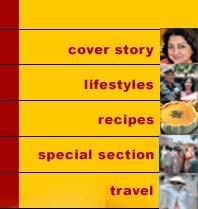
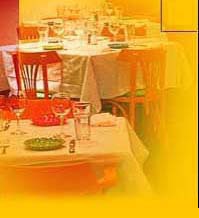

|
|
|
I have always had an enormous and almost insatiable thirst for travel � and over the decades, this has led me to near and distant shores, in a continuous search for something new. The Mother�s Charter for Auroville even in 1968 was simple and clearly stated: Auroville belongs to nobody in particular, Auroville belongs to humanity as a whole, but to live in Auroville one must be a willing servitor of the Divine Consciousness; Auroville will be the place of unending education, of constant progress, and a youth that never ages; Auroville wants to be the bridge between the past and the future, taking advantage of all discoveries from without and from within, Auroville will boldly spring towards future realisations; Auroville will be a site of material and spiritual researches for a living embodiment of an actual Human Unity.
As for their attire, the women normally wear Ilkal handloom sarees with the traditional Ilkal-khan blouse and also use the wellknown local Kasuti embroidery on their garments. For jewellery they adorn a kajji sera which is like a jhumkar made of small gold beads and a nath in their nose. The men wear dhotis and roomal (a type of pheta). The movement was started by a far sighted government minister in the early Bijjal Kingdom near Bijapur, named Basavanna, who was highly progressive in his thinking and preached of a casteless society. This great reformist paved the earliest path for the liberation of women and combated the polytheistic forces of Brahmanic Hinduism. He was also a great poet and his poems Vachanas are greatly treasured. Amongst his many earlier followers, was a woman poet named Akka Mahadevi. They practiced a social order totally devoid of the caste system and social servitude. Because of their large numbers, in the early 1900s they actually decided upon the political fortunes of the major political parties in Karnataka. A few names that come to mind of prominent Lingayats are Nijalingappa, the late Congress president in 1969, India's former Vice-President B. D. Jatti, Virendra Patil, former chief minister of Karnataka, and Shivraj Patil, presently India's Union Home Minister.
The major festivals of the Lingayats are Ugadi (the beginning of the New Year), Maha Shivratri, Basava Jayanthi (the birthday of their guru, Lord Basaveshwara), Makkar Shankaranama and Kara Hummime observed by the farmers. The Lingayats are vegetarian in their food habits � and now a short description of their typical food preparations. The most popular dish at every marriage is the Godi Huggi � it is a delicious pudding made from fresh wheat-germ boiled with varieties of sweet condiments, jaggery and topped with ghee. Other sweet dishes are the ' Hoorana Holige, a type of puran poli and the rawa poli which is balls of rawa and gur made into a poli. Daily items are jawar roti eaten with mudda bhaji (leafy vegetables with three varieties of lentils) and bharva baingan � brinjals made with the kala til chutney and special Karnataka masala.
And a brief description of some of their chutneys: Metkut � a powder of roasted cereals with methi; Karal ki chutney � a rustic version of the black til eaten with rice; Agasi hindi chutney � made out of linseed; Chinchecha thecha � raw tamarind chutney; Thechas � very pungent, made from green or red chillies. Usually several of these chutneys are placed onto a kati roti (made of bajri). Then along with pieces of this kati roti these chutneys are relished along with thick dahi. The snacks prepared by them are Uppit, Mirchi Bajji, Maize Nuchha and Curds Chumure Soosla and Seijji Kadabu. A very interesting and industrious community, indeed.
|

Home Page
About the mag
Subscribe
Advertise
Contact Us
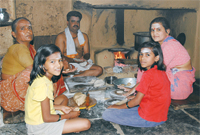 Lingayat Cuisine!
Lingayat Cuisine!
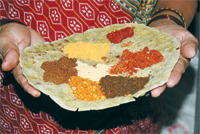 Recently, nearer home, on a brief visit to Belgaum in North Karnataka, I made my very first acquaintance with the lesser known Lingayat Community, which started as early as in the 12th century as a miniscule socio-religious movement. Lingayats are a Hindu sect, concentrated mostly in Northern Karnataka, Southern Maharashtra and pockets of Andhra Pradesh. The name can be explained this way � the lingam is the form of Lord Shiva, and yat means community. In fact, they constitute 20 per cent of the population of Karnataka with the majority found in Bijapur, Belgaum and Dharwad.
They are very clearly identified by the three lines of vibhuti (sacred ash) on their foreheads and are known as Virasaivas, because of their steadfast devotion to Shiva. Devotees always carry the lingam around their necks or across their chests, from birth till death. They follow different ways of worshipping the lingam and do not believe in idol worship. Even their funeral system is rather unusual. Lingayats do not believe in cremation and are buried in separate burial grounds in a cross-legged upright position, along with preservatives like salt and vibhuti.
Recently, nearer home, on a brief visit to Belgaum in North Karnataka, I made my very first acquaintance with the lesser known Lingayat Community, which started as early as in the 12th century as a miniscule socio-religious movement. Lingayats are a Hindu sect, concentrated mostly in Northern Karnataka, Southern Maharashtra and pockets of Andhra Pradesh. The name can be explained this way � the lingam is the form of Lord Shiva, and yat means community. In fact, they constitute 20 per cent of the population of Karnataka with the majority found in Bijapur, Belgaum and Dharwad.
They are very clearly identified by the three lines of vibhuti (sacred ash) on their foreheads and are known as Virasaivas, because of their steadfast devotion to Shiva. Devotees always carry the lingam around their necks or across their chests, from birth till death. They follow different ways of worshipping the lingam and do not believe in idol worship. Even their funeral system is rather unusual. Lingayats do not believe in cremation and are buried in separate burial grounds in a cross-legged upright position, along with preservatives like salt and vibhuti.
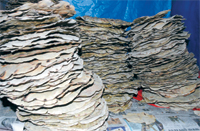 Today the community is concentrating largely on educational expansion and in this field, the foremost person in Belgaum is Prabhakar Kore, the chairman of the highly prestigious KLE Society � the Karnataka Lingayat Education Society. His latest contribution is into providing health services in the far off villages, by opening many satellite health centres.
On this trip I got to meet several members of the Lingayat community who were associated with various other aspects of everyday living � like a few restaurateurs and some talented ladies who engaged themselves in preparing many traditional varieties of chutneys and spice powders at home. We even visited the 'Home Shoppi' of Seema Kulkarni and were amazed by the large selection. At M. B. Hubli's popular Charaka Mess, we found an energetic young woman preparing the traditional bhakri, right in front of us. Sitting near the woodfire on the ground, she excelled at making over 700 of them every day with amazing dexterity. Tempted by the aroma, we easily succumbed into
ordering a complete thali of terrific junkhar bhakri along with accompanying vegetables.
Another typical Lingayat restaurant we visited was Mallikarjun's Boarding Place established in 1952 and located at the very central Sheri Circle. The entrance wall displayed several family photos in traditional attire. Here the two brothers, Mallikarjun and Chandrashekhar, have a 15 bench dining room where the average worker is able to lunch or dine on a thali for a mere Rs 15. The meal comprises two jowar rotis, rice, two vegetables, kachumbar and some local chutney. They receive about 150 people at lunchtime and 130 at night.
Today the community is concentrating largely on educational expansion and in this field, the foremost person in Belgaum is Prabhakar Kore, the chairman of the highly prestigious KLE Society � the Karnataka Lingayat Education Society. His latest contribution is into providing health services in the far off villages, by opening many satellite health centres.
On this trip I got to meet several members of the Lingayat community who were associated with various other aspects of everyday living � like a few restaurateurs and some talented ladies who engaged themselves in preparing many traditional varieties of chutneys and spice powders at home. We even visited the 'Home Shoppi' of Seema Kulkarni and were amazed by the large selection. At M. B. Hubli's popular Charaka Mess, we found an energetic young woman preparing the traditional bhakri, right in front of us. Sitting near the woodfire on the ground, she excelled at making over 700 of them every day with amazing dexterity. Tempted by the aroma, we easily succumbed into
ordering a complete thali of terrific junkhar bhakri along with accompanying vegetables.
Another typical Lingayat restaurant we visited was Mallikarjun's Boarding Place established in 1952 and located at the very central Sheri Circle. The entrance wall displayed several family photos in traditional attire. Here the two brothers, Mallikarjun and Chandrashekhar, have a 15 bench dining room where the average worker is able to lunch or dine on a thali for a mere Rs 15. The meal comprises two jowar rotis, rice, two vegetables, kachumbar and some local chutney. They receive about 150 people at lunchtime and 130 at night.
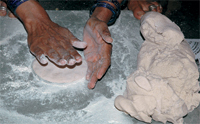 Katin saru is a watery lentil soup, the kharbyali is a typical Lingayat dal.
Sardge are papad-like dried rice and onion balls, to be fried and eaten.
Lahache pith is jowar, roasted like popcorn, made into flour, rolled into balls and eaten with sugar and ghee.
Katin saru is a watery lentil soup, the kharbyali is a typical Lingayat dal.
Sardge are papad-like dried rice and onion balls, to be fried and eaten.
Lahache pith is jowar, roasted like popcorn, made into flour, rolled into balls and eaten with sugar and ghee.